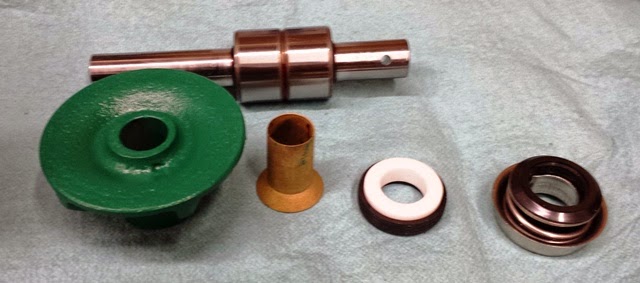It's hard to believe that the restoration of The Alfatross began almost two years ago. Knowing what I know now, it's even harder to believe that I ever thought it could be done in just one year! With 2015 fast approaching it's time for updates from the guys who are working on The Alfatross' sub-assemblies. Here are their latest reports:
The Chassis and Body (Tim Marinos at Vintage Autocraft)
 |
| The Alfatross at Vintage Autocraft. Tim Marinos |
"Zagato built beautiful car bodies but was not well known for exceptional fit and finish. I heard a restorer tell his customer, 'The great thing is it’s a Zagato' and in the same breath, 'The difficult thing is that it’s a Zagato.'
 |
| "The good news is, it's a Zagato. The bad news is . . . . " |
 |
| The hood skin minus its steel framework. Tim Marinos. |
With the vast majority of the underbody repairs to The Alfatross complete, we
now focus on fitting the body components. One of the more tedious aspects of the restoration process
is repairing past “sins” or issues such as poor build quality, poor repair methods,
and existing damage and decay. This requires repairing and fitting up virtually
every part pertaining to the body: all open and shut panels, window mechanisms,
latches, trim, bright work etc. Rubber seals must be sourced, fitted and modified
or made if an original style is not available.
 |
| The hood skin with frame reattached. Tim Marinos. |
Every screw hole must be
checked, re-welded if needed and sized for the correct hardware. During final
assembly is not the time to deal with stripped out 2.9 mm trim screw holes! The
extra effort spent at this stage returns in spades down the home stretch in terms of time and stress.
We must
always be aware of the need to maintain a balance between fixing poor build quality issues and over-restoring. I always go back to the intent of the builder and take it to the
highest level which is evident that they could achieve over all. This is the
course we are following with The Alfatross."
The Engine (DeWayne Samuels, Samuels Speed Technologies)
The Interior (Derrick Dunbar, Paul Russell and Company)
Everything Else (Me, Steward for The Alfatross)
When the body and chassis come back to Santa Fe I need to be ready to install all the other components except the upholstery. Many of them are compete, but there is still plenty left to do. Jeff Kramer, The Alfatross' chief Web scrounger, recently sent me a link to an ebay ad by Luma di Mazzotti Gianluca for a complete original Alfa 1900 radiator, thermostat, shutter and linkage assembly. I didn't really need the radiator or shutter, but the thermostat and its intricate linkage alone were worth the purchase. Incredibly, it arrived less than a week later!
 |
The radiator from The Alfatross (right) dwarfs the one
just received from Italy. |
I was surprised to discover that the radiator and shutter were shorter than the Alfatross', although the other dimensions were the same. It made me wonder if Alfa supplied different radiator types for different engines, or whether different body shapes required lower radiator height.
 |
| The shutters are sized proportionately. |
 |
| The wiring harness laid out for testing. Front of the car is at the top. |
One of the other facets of the restoration I'm working on now is the wiring harness. I had the original duplicated years ago by YnZ's Yesterday's Parts, but until now it had never been laid out. My intent is to test each circuit and each electrical component to make sure they are functional before installing the harness in the car. Although the harness and components are relatively simple, there are plenty of opportunities to get wires crossed. Fortunately, YnZ numbered each wire and supplied 4 pages of notes on what they connect to based on the labels I attached when I removed the original harness and on their years of experience with this sort of thing. I also had 9 pages of schematics sent to me decades ago by Berge Bergesen, another 1900 Z owner and notes by Peter Marshall on how to improve the exterior lighting system.
 |
| Things get a little complicated in the vicinity of the dashboard. |
Separation Anxiety
I have to admit to being anxious about how long this restoration is taking. I am well aware that The Alfatross is not the only car these guys (even me!) are working on, or even their highest priority (except for me!). Over the 45 years I have been taking care of The Alfatross my experience with contractors has ranged from utter frustration with charlatans to mild amusement over some of the citations from The Book of Excuses I have been offered, to a sense of awe at the knowledge and competence demonstrated by the true professionals.
If I ever do this again I will definitely establish agreements with anyone I contract with for when their part of the job will be finished. If a potential contractor cannot or will not do that I will look elsewhere.





















































